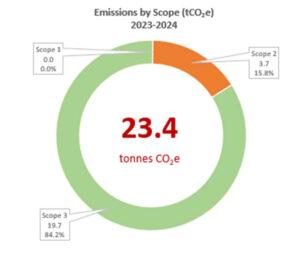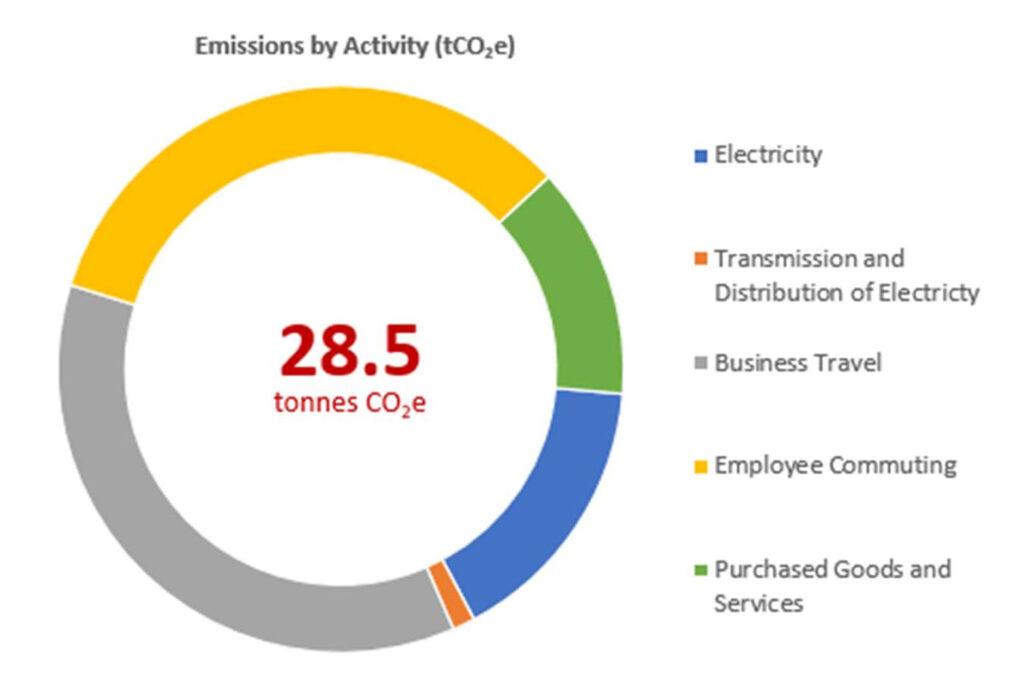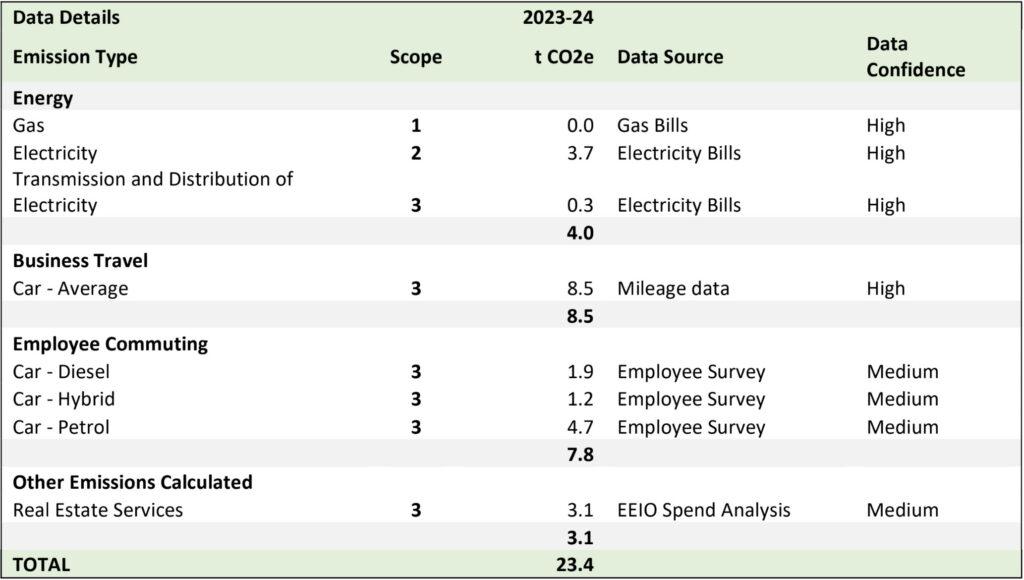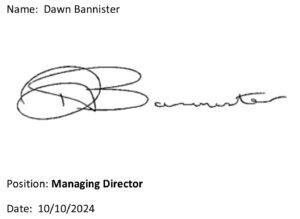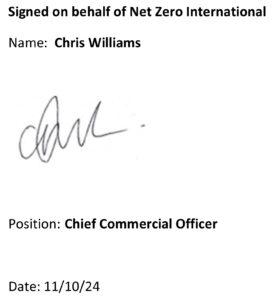Carbon Reduction Plan
1 Net Zero Commitment
KSB Recruitment recognises the importance of making a full and lasting commitment to reducing the greenhouse gas emissions from our activities, in support of the wider commitment of the world to limit global temperature increases and the impact on the planet.
We commit to the following:
- For our company to achieve Net Zero in line with the Science Based targets set out by the UNFCCC i.e., to achieve Net Zero no later than 2050 and target a 50% reduction in emissions by 2030.
- To set realistic short- and long-term targets that are designed to achieve our Net Zero commitments.
- To report the total Greenhouse Gas emissions of our business, at a minimum, on an annual basis.
| Year | Earlier Year if Possible | |
|---|---|---|
| Commitment to be Net Zero | 2050 | 2045* |
| 50% Emissions Reduction | 2030 |
2 Background Information
2.1 Company
KSB Recruitment is a Limited Company registered in England and Wales, company number 04542522, with a registered office address of Zenith House, Highlands Road, Shirley, Solihull, England, B90 4PD.
KSB Recruitment we are a specialist recruitment agency with over three decades of experience in providing catering and hospitality businesses across England with top-tier temporary and permanent staffing solutions. Our business is built on a foundation of integrity, reliability, and excellence, and we continue to set the standard for recruitment in the industry.
What We Do
We offer comprehensive recruitment services, filling temporary, contract, and permanent positions. Whether businesses need chefs, catering assistants, porters, cleaners, or other non-clinical roles, we connect them with dedicated, skilled professionals who are ready to excel in their roles.
Our approach goes beyond just filling vacancies. We focus on understanding the unique needs of both clients and candidates to ensure a perfect match that benefits all parties. Our tailored, transparent, and client-focused recruitment process allows us to build long-lasting partnerships with the businesses we serve.
Our History
KSB Recruitment was established in 1991, during the height of a major recession, after our founder was made redundant. From these humble beginnings, we have grown into a leading recruitment agency with a passion for changing lives through meaningful employment. Over the last 30 years, we have built a reputation for honesty, exceptional service, and continuous improvement, enabling us to develop a loyal client base.
With our extensive experience, we remain at the forefront of the catering and hospitality recruitment industry. Today, KSB is recognised for its commitment to exceeding expectations for clients and candidates alike, as we continue to expand our services into sectors such as healthcare for non-clinical roles.
| Reporting Period | Current Period July 2023 – June 2024 |
|---|---|
| Industry | Recruitment |
| No. of Staff | 11 |
| No. of Premises Owned | 0 |
| No. of Premises Leased | 1 |
| No. of Company Vehicles – Owned | 0 |
| No. of Company Vehicles – Leased | 0 |
2.2 Current Reporting Period
July 2023 – July 2024
2.3 Organisational Boundary
There are 3 different approaches to measuring emissions, as defined by the GHG Protocol. This report has been constructed using the Operational Control Approach, considering the requirements of each potential approach.
| Approach Description | Approach Taken |
|---|---|
| Operational Control The organisation has operational control over an operation if it or one of its subsidiaries has the full authority to introduce and implement its operating policies at the operation. |
✓ |
| Financial Control The organisation has financial control over the operation if it has the ability to direct the financial and operating policies of the organisation with a view to gaining economic benefits from its activities. |
|
| Equity Share The organisation accounts for GHG emissions from operations according to its share of equity in the operation. |
2.4 Benchmark Year
The organisation’s benchmark year is from July 2023 – June 2024. This is the first time the organisation has measured and reported on its carbon emissions.
2.5 Methodologies Used
Throughout this report all methodologies used are explained within the relevant sections.
3 Carbon Emissions Overview
23.4
tonnes CO2e
The total calculated emissions for the business for the period 2023-2024 are 23.4 tCO2e. This is the first year the company has measured its carbon emissions. As such this is the benchmark year of the company with the breakdown of emissions analysed throughout this report.
The Company will aim to measure an increasing amount of Scope 3 emissions and is committed to reducing their emissions across all scopes.
4 Analysis by Scope
| Scope | Description | tCO2e | % |
|---|---|---|---|
| Scope 1 | There were no scope 1 emissions reported in the recording period. KSB Recruitment do not have any company vehicles, and heating is done through electric heaters. | 0.0 | 0.0% |
| Scope 2 | Emissions in scope 2 includes electricity used at the company’s office. The office is not on a renewable tariff. | 3.7 | 15.8% |
| Scope 3 | Emissions in scope 3 include: • Business Travel • Employee Commuting • Transmission and Distribution of Electricity • Landlord Services (including Waste and Water). |
19.7 | 84.2% |
| TOTAL | 23.4 | 100% |
Reported Scope 3 emissions may increase in future years as more detailed data and information becomes available.
5 Emissions by Activity
• No courier or Hotel emissions incurred during the report year.
6 Intensity Metric Analysis
Intensity metrics help normalise emissions data, taking into account variations in production levels or activity volumes. This allows for a more accurate assessment of emission trends over time, regardless of changes in business operations. The initial intensity metrics for the company are below and will be used for comparative purposes in following years.
Intensity Metrics (tCO2e)
7 Emissions Reductions Targets
The following graph summarises the carbon emissions reduction targets.
8 Carbon Reduction Actions
KSB Recruitment will develop the following initiatives that will support the company’s strategies to meet Science Based Targets:
| Area of Focus | Initiative |
|---|---|
| Engagement of Team | To engage the entire team throughout the organisation in the Net Zero transition plan and to encourage staff to support lower carbon ideas, opportunities, and activities. |
| Reduce Reliance on Spend Based Data | To review major emissions based on spend and develop more accurate emissions data together with suppliers. |
| Business Travel Emissions | To review a sustainable travel policy encouraging use of public transport and lower carbon options when practical to do so. |
| Fleet Strategy | To review on a regular basis the availability and feasibility of technology to enable changing fleet vehicles to lower emission engines and eventually from ICE to hybrid or electric engines. |
| Supply Chain Review | To carry out regular reviews of supply chain partners and introduce a sustainable supply chain policy over time. |
| Energy Efficiency of Site | Review infrastructure to reduce energy consumption. Investigate renewable energy generation possibilities on site. Investigate improved waste recyclability options. |
9 Emissions Data
The data contained in the table below represents total emissions calculated and is consistent with SECR requirements. All sources of emissions that have been measured are included in the totals below. Emissions from key activities are summarised in the previous sections.
10 Standard and Methodology Used
KSB Recruitment categorises its Greenhouse Gas (GHG) Emissions as Scope 1, 2 or 3 as referred to in the WBCSD – WRI Greenhouse Gas Protocol (revised edition, dated March 2014). Emissions in Carbon Dioxide equivalent (CO2e) for all scopes are calculated using the conversion factors listed in DESNZ Greenhouse Gas Conversion Factors for the relevant 12-month period over which the carbon emissions are calculated. Procured renewable electricity and gas is calculated in accordance with the WBCSD – WSI Scope 2 Guidance on procured renewable energy (2015).
11 Data Quality / Confidence
The data used to generate this report has been collected from various sources from both within the company and using assumptions gathered by Net Zero International. These emissions have been converted to CO2e using GHG Protocol and DESNZ frameworks and conversion factors for the relevant period.
12 Declaration and Sign Off
This Carbon Reduction Plan has been completed in accordance with SECR, PPN 06/21 and associated guidance and reporting standard for Carbon Reduction Plans.
Emissions have been reported and recorded in accordance with the published reporting standard for Carbon Reduction Plans and the GHG Reporting Protocol corporate standard and uses the appropriate Government emission conversion factors for greenhouse gas company reporting.
Scope 1 and Scope 2 emissions have been reported in accordance with SECR requirements, and the required subset of Scope 3 emissions have been reported in accordance with the published reporting standard for Carbon Reduction Plans and the Corporate Value Chain (Scope 3) Standard.
This Carbon Reduction Plan has been reviewed and agreed by the board of directors (or equivalent management body).
13 Glossary
| Term | Definition |
|---|---|
| Benchmark Data | The chosen 12-month period that sets the calculated emissions that need to be mitigated and/or offset. |
| Carbon Reduction | Reduction in measured CO2e emissions. |
| Carbon Reduction Plan | Plan to reduce CO2e emissions over a period of time, updated annually. |
| Carbon Emissions (Gross) | CO2e emissions from Company activities. |
| Carbon Emissions (Net) | CO2e emissions from Company activities minus verified carbon offsets the Company purchases. |
| Carbon Neutral | When emissions are fully offset including those emissions that could be mitigated. |
| Carbon Offsets | A removal or reduction of carbon emissions through a verified scheme. |
| CO2e | All greenhouse gases expressed in terms of Carbon Dioxide equivalent (CO2e) for consistency of reporting. |
| DESNZ | Department of Energy Security and Net Zero (link). |
| EEIO | Environmentally Extended Input Output – Emissions estimated on spend (link). |
| Organisational Boundaries | GHG Protocol Organisational Boundaries (link). |
| GHG Protocol | Greenhouse Gas Protocol (link). |
| Greenhouse Gases | Carbon Dioxide (CO2), Methane (CH4), Nitrous Oxide (N2O), Chlorofluorocarbons (CFCs and HCFCs), Hydrofluorocarbons (HFCs), Perfluorocarbons (PFCs), Sulphur Hexafluoride (SF6). |
| Greenhouse Gas Conversion Factors | Annually published conversion factors normally published by relevant government departments. Converts activity into CO2e emissions. |
| Greenhouse Gas Emissions (GHG) | Gases in the atmosphere that absorb and radiate heat. |
| Intensity Metric/Ratio | A metric that measures carbon emissions per relevant unit of activity in a business. |
| Market Reporting v Location Reporting | Market is based on specific tariffs. Location is based on the country from which you are reporting. |
| Net Zero | GHG emissions are mitigated and those that cannot are offset. |
| Renewable Tariff | An energy tariff that is 100% powered by renewable energy and is certified. |
| SBT | Science Based Targets – reducing emissions by 50% by 2030 and by 90% by 2050 and offsetting the remaining amount. |
| Scope 1 | The fuels that are burnt (gas, transport the company owns, refrigerant gases). |
| Scope 2 | The energy that is bought (electricity from the grid, purchased heat). |
| Scope 3 | Emissions embedded in everything a company buys and emitted as a consequence of everything a company sells. |
| SECR | Streamlined Energy and Carbon Reporting. |
| tCO2e | Metric tonnes of CO2 equivalent emitted. |
| WBCSD | World Business Council for Sustainable Development (link). |
| WRI | World Resource Institute (link). |
